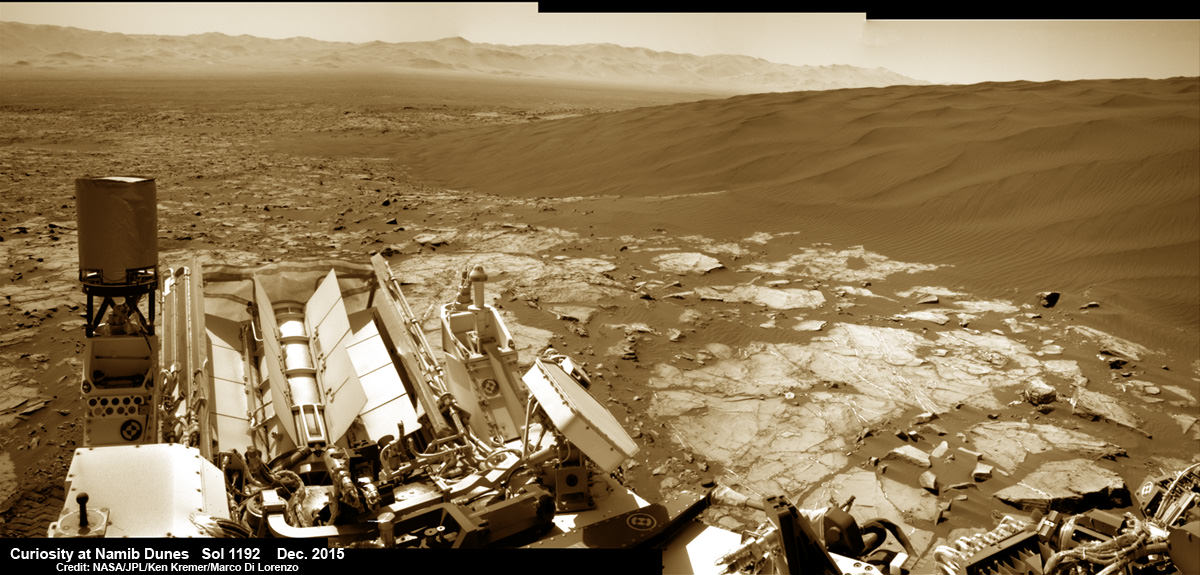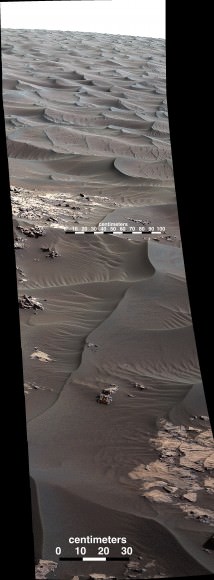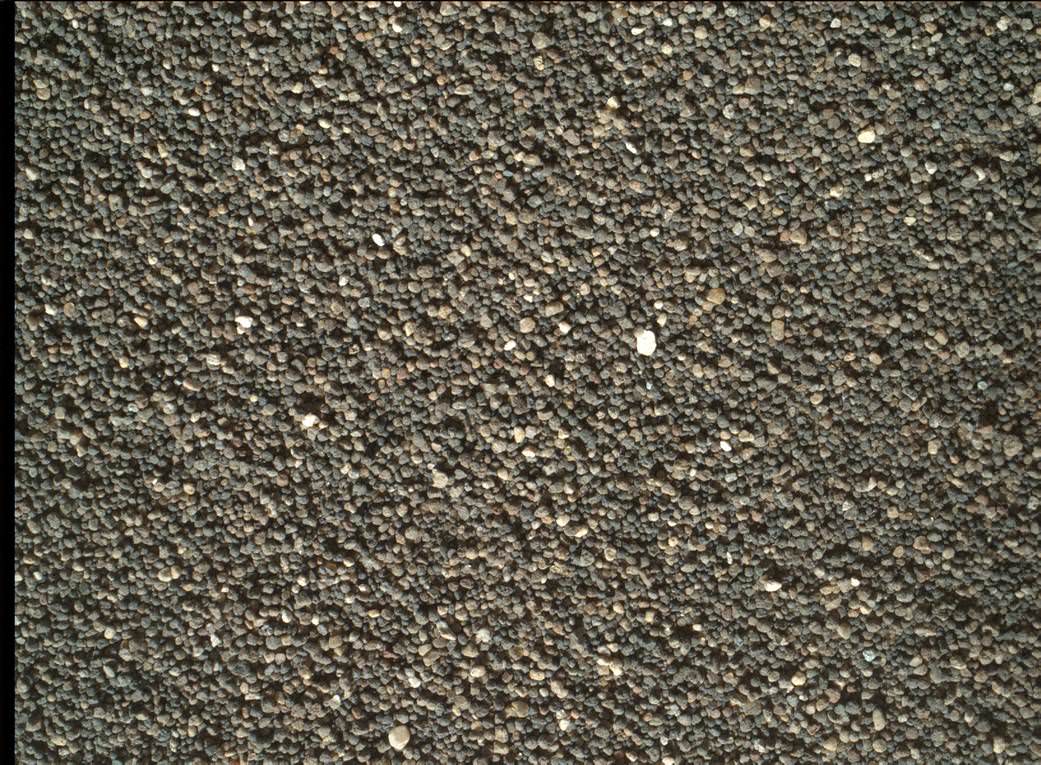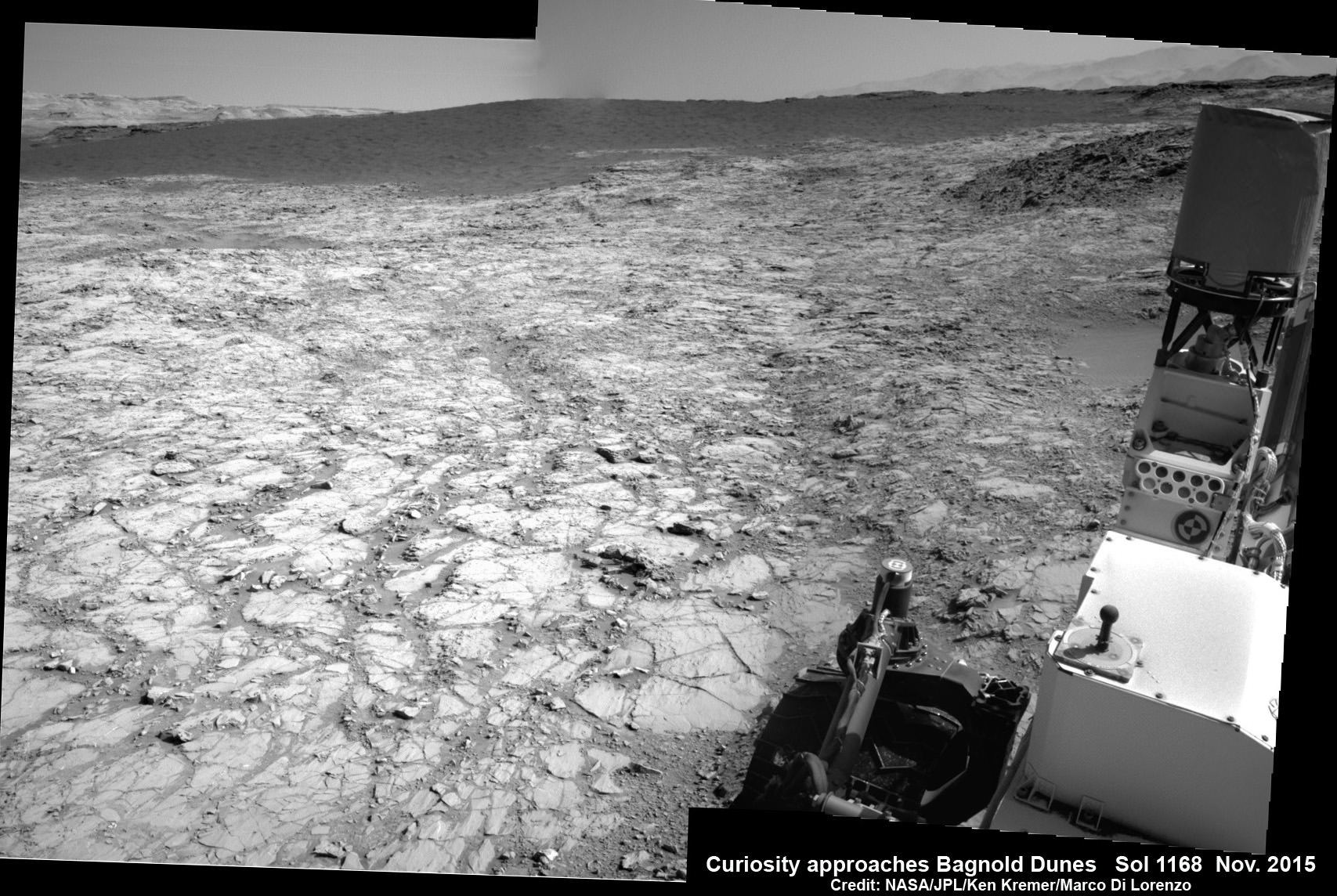
Curiosity explores Namib Dunes at base of Mount Sharp, for first in-place study of an active sand dune anywhere other than Earth. See Gale Crater rim in the distance.This colorized photo mosaic is stitched from navcam camera raw images taken on Sol 1192, Dec. 13, 2015. Credit: NASA/JPL/Ken Kremer/kenkremer.com/Marco Di Lorenzo
After many months of painstaking driving, NASA’s Curiosity Mars rover has reached the edge of a massive field of spectacular rippled sand dunes located at the base of Mount Sharp that range up to two stories tall. And she has now begun humanity’s first up-close investigation of currently active sand dunes anywhere beyond Earth.
The dark dunes, named the “Bagnold Dunes,” skirt the northwestern flank of Mount Sharp and lie on the alien road of Curiosity’s daring trek up the lower portion of the layered Martian mountain.
Today, Dec 14, Curiosity is exploring a spectacular spot dubbed the “Namib Dune” shown in our new photo mosaic above.
Ascending and diligently exploring the sedimentary lower layers of Mount Sharp, which towers 3.4 miles (5.5 kilometers) into the Martian sky, is the primary destination and goal of the rovers long term scientific expedition on the Red Planet.

The car sized rover initially arrived a few sols ago at a spot of the rippled surface that’s been informally named “High Dune” by the team of scientists and engineers leading Curiosity’s Mars Science Laboratory (MSL) Mission on Mars.
“The science and engineering team are excited about the opportunity to study active dunes on another planet,” wrote MSL science team member Lauren Edger, Research Geologist at the USGS Astrogeology Science Center, in a mission update.
The dunes are indeed rather active and have been determined to migrate up to about one yard or meter per year, based on orbital observations gathered by NASA’s Red Planet orbiter fleet – including the Mars Reconnaissance Orbiter (MRO).
The magnificent looking “Bagnold Dunes” have been quite noticeable in numerous striking images taken from Mars orbit by MRO and during the vehicles nail biting ‘7 Minutes of Terror’ descent from orbit – as well as in thousands upon thousands of images taken by Curiosity herself as the robot edged ever closer during her over three year long traverse across the floor of the Gale Crater landing site.
Curiosity must safely cross the expansive dune field before even attempting to climbing Mount Sharp.
Although multiple NASA rovers, including Curiosity, have studied much smaller Martian sand ripples or drifts, none has ever visited and investigated up close these types of large dunes that measure in size as tall as a two story building or more and are as wide as a football field or more.

Before crossing the dune field, the team is conducting mobility tests by carefully driving Curiosity just “a few meters into the dark sand in front of the rover, then back up enough to allow study of the rover tracks using the arm instruments,” said Ken Herkenhoff, Research Geologist at the USGS Astrogeology Science Center and an MSL science team member.
The mobility tests at ‘High Dune’ have gone well.
“We drove a little ways into a sand patch and then backed out, leaving trenches where the wheels were. Yes, we’re disturbing some of the very photogenic sand ripples that we have been seeing, but it’s for a good cause: it teaches us more about how well we can drive in that sand, and by using the wheels to make trenches like this, we can get a better idea of the internal structure of the sand ripples,” says MSL team member Ryan Anderson.
The team is using the six wheel rovers mast mounted cameras and spectrometer and instruments mounted on the robotic arm, such as the MAHLI camera and APXS spectrometer, for contact science studies of the soil and rocks at ‘High Dune’ and the new wheel tracks.
The science ops are also progress extremely well.
“We’ve accomplished a lot of reconnaissance imaging of the dunes, and we’re looking ahead to monitoring the dune slipface and sampling the chemistry and mineralogy of an active dune. We’ve also acquired some beautiful close-up images of the sand grains, as seen MAHLI images that just came down,” noted Edger.

The dark dunes are informally named after British military engineer Ralph Bagnold (1896-1990), who conducted pioneering studies of the effect of wind on motion of individual particles in dunes on Earth. Curiosity will carry out “the first in-place study of dune activity on a planet with lower gravity and less atmosphere.”
“These dunes have a different texture from dunes on Earth,” said team member Nathan Bridges, of the Johns Hopkins University’s Applied Physics Laboratory, Laurel, Maryland.
“The ripples on them are much larger than ripples on top of dunes on Earth, and we don’t know why. We have models based on the lower air pressure. It takes a higher wind speed to get a particle moving. But now we’ll have the first opportunity to make detailed observations.”
After completing work at ‘High Dune’ the team directed Curiosity to another dune location named ‘Namib Dune.’
“The view is pretty spectacular,” says Edger.

Stay tuned here for Ken’s continuing Earth and planetary science and human spaceflight news.
Ken Kremer
